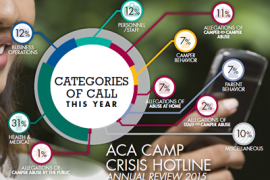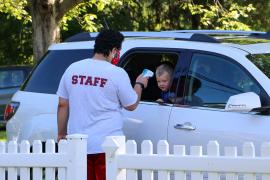As of this August, there were 2,247 ACA-accredited camps. Of these camps 1,131 (50.3 percent) have challenge/ropes courses. A new study published in the journal, Wilderness and Environmental Medicine, provides some interesting facts about fatalities connected to challenge (ropes) courses. The study, “Sudden Unexpected Death on Challenge Courses,” examined incidents resulting in death (traumatic and non-traumatic) during or within thirty minutes of the completion of ropes course events. The study utilized multiple data sets and multiple analysis techniques including: review of accident injury data available through Project Adventure; anecdotal reports from presentations conducted by the Association of Challenge Course Technology (ACCT); personal interviews with individuals involved in incidents; and review of press releases and other print material related to the incidents.
According to the study, fifteen deaths between 1986 and 2000 can be attributed to participation in a ropes course-related activity.
- Five of these deaths were traumatic due to a fall from height.
- Four of these five incidents involved the fall of a staff person.
- All falls were from a Zip Line element or a platform at the start point for this element and can be clearly attributed to failure to observe published installation or operational standards.
- The other ten deaths were the result of sudden cardiac death (SCD).
- All incidents involved men between the ages of thirty-three and sixty.
The study did not differentiate between staff and participant in SCD incidents.
Some context for analysis was provided in the article. According to Project Adventure, the known number of ropes courses in the United States is 7,750. Combining this information with data from other Project Adventure reports about mean hours of participation in ropes courses events, it was conservatively estimated that the period of this review comprised 194,800,000 participant hours. Therefore, the SCD rate according to this study was 1 per 19,480,000.
“Establishing denominators for such incidents rates is difficult,” the study reports, “but this number [19,480,000] appears to be about 100-fold below that reported for marathon running (1 per 215,000 hours), a sport for which fairly accurate statistics are available.”
The level of SCD occurrence in connection with ropes course activities is consistent with the same data when analyzed for serious injury. Serious injury is defined as an injury resulting in one or more days lost from school or work. For this data set, occurrence of serious injury was set at 4.33 per one million participant hours.
Ropes course operators frequently screen for cardiac risk prior to participation. This report noted that “medical literature is quite consistent in questioning the usefulness of such screening.”
Copies of this report can be obtained through a library. Full reference is: Thomas R. Welch & Robert Ryan, “Sudden Unexpected Death on Challenge Courses”, Journal of Wilderness and Environmental Medicine, v. 13, 140-142, 2002. For more information, contact the Wilderness Medical Society online at www.WMS.org, or call 719-572-9255.
Originally published in the 2002 Fall issue of The CampLine.


